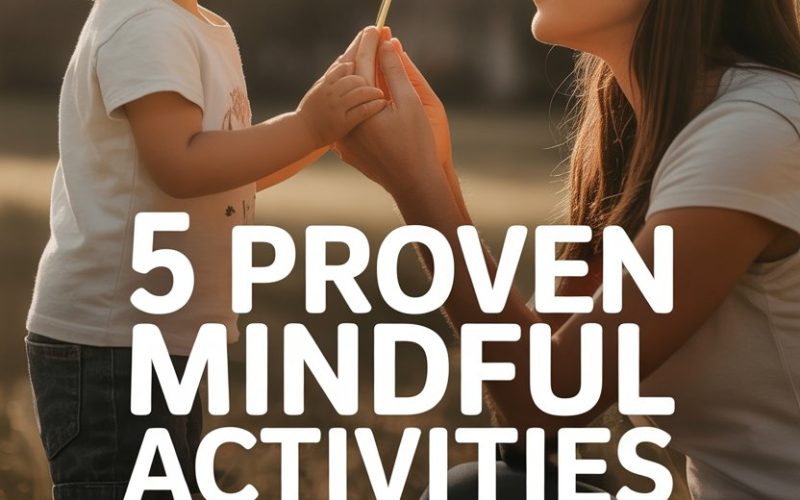Ever tried to teach a toddler the meaning of “patience” while you’re frantically looking for socks, shoes, and your own sanity? Welcome to parenthood.
For many of us, cultivating mindfulness with our kids sounds about as achievable as maintaining a clean car for more than 48 hours.
Yet, the science is clear: mindful activities can help children develop emotional resilience, focus, and joy—without requiring parents to transform into Zen masters or start folding laundry the Marie Kondo way.
Here’s the good news: five simple, research-backed mindful activities fit into even the most hectic family schedules.
No incense required. Just bring yourself, your offspring, and a willingness to try something new (and possibly giggle while doing it).
1. Family Belly Breathing
Before you picture a room full of yogis chanting “Ommm,” let’s get real. Belly breathing is less about enlightenment and more about teaching kids (and honestly, ourselves) how to find calm in chaos.
Research shows that even a few minutes of mindful breathing can lower stress hormones in children. That’s right: just a few deep breaths.
How to do it? Have everyone lie down on their backs—yep, on the living room floor is fine. Place a soft toy or cushion on each belly.
Invite your kids to watch the toy rise and fall as they slowly breathe in through their noses and out through their mouths. You can call it “making your teddy ride the ocean waves.” If the giggles take over, you’re doing it right.
Consistency is key here. Consider squeezing in a minute or two after teeth-brushing or before school drop-off.
Not only does this practice help children regulate emotions, but you might also discover your own grown-up version of calm—between bursts of Peppa Pig and forgotten backpacks.
2. The Five Senses Walk
Mindfulness experts often recommend “grounding” exercises to help both adults and kids focus on the present.
Enter the Five Senses Walk: a magical parenting trick disguised as a stroll around the block (or a march around your garden, if leaving the house feels ambitious).
The process couldn’t be simpler: as you walk, encourage your child to notice one thing they can see, hear, smell, touch, and (if it’s safe) taste.
Maybe it’s the squish of mud underfoot, the screech of a magpie, the scent of fresh-cut grass, the rough bark of a tree, or a not-so-sneaky nibble of a homegrown strawberry.
This activity works wonders for busy families, because it transforms the ordinary (walking to school, running errands) into an adventure. Studies have found that sensory awareness can reduce anxiety in young children and boost their ability to focus.
Bonus: adults get a chance to slow down and marvel at the tiny details we so often miss. (Or, at the very least, discover what small creatures your child considers edible.)
3. Mindful Mealtime Moments
Picture this: you set a lovely dinner table, everyone sits down with impeccable manners, and you engage in meaningful conversation. Now, back to reality—most of us are refereeing pea catapults or negotiating bites of broccoli.
Even so, mealtimes offer an opportunity for mindfulness.
Many pediatricians recommend introducing a “mindful bite” practice: ask everyone to pause before eating, notice the colours and smells on their plate, then slowly take a bite, paying attention to taste and texture.
You might even make a game out of it—who can describe their food using the silliest words? “This carrot tastes like crunchy sunshine!” If you get a chorus of “Ewww,” you’re not alone.
Research from nutritionists and child development experts suggests that mindful eating helps children recognise internal hunger and fullness cues, setting the stage for lifelong healthy habits.
As a bonus, children may become more adventurous eaters (eventually—Rome wasn’t built in a day, and neither is a toddler’s palate).
If a quiet, screen-free meal feels light-years away, try a single “mindful bite” together. Celebrate the small wins—like getting everyone to sit for two consecutive minutes.
4. Gratitude Jars and Routines
Gratitude can sound like one of those “shoulds” that parents add to a never-ending list: “I should be more grateful my child only drew on one wall today.”
Yet, research shows that children who practice gratitude regularly show increased happiness, better friendships, and even improved sleep. Yes, sleep!
Creating a Gratitude Jar is as easy as raiding your recycling bin. Find any old jar or box, decorate it together, and keep a stash of paper slips nearby.
Each night, everyone writes or draws one thing they’re thankful for—no moment too small or silly. “I’m grateful for puddle jumps!” is just as valid as “I’m grateful Mum remembered my lunch.”
Some families prefer gratitude journals or a nightly sharing circle at bedtime. The key is making it part of your routine, not another chore. Keep it lighthearted. If your child (or partner) rolls their eyes, you’re in good company.
Over time, this ritual builds emotional literacy and resilience—plus, the jar becomes a treasure trove of family memories for rainy days.
5. Mindful Storytime
Reading together is the gold standard of bonding, but it’s also a sneaky way to teach mindfulness. Mindful storytime isn’t about speed-reading five books before you collapse; it’s about slowing down and inviting curiosity.
Pick a story—old favourite or new adventure. Pause to look at the illustrations.
Ask open-ended questions: “How do you think the character feels right now?” “What would you do if you were in their shoes?”
This kind of shared reflection not only builds empathy, but also encourages children to notice emotions and reactions, both in themselves and in others.
Children’s books are full of mindful themes: patience, kindness, taking deep breaths when frustrated.
Some books, like “Listening to My Body” by Gabi Garcia, weave mindfulness directly into the story. Others, like a classic bedtime tale, offer gentle opportunities to practice attention.
If your child interrupts, sings, or launches into interpretive dance mid-story, congratulations—you’ve captured real life. Mindful storytime is about connection, not perfection.
Happy Children, Happier Parents
Life with kids is a messy, unpredictable enterprise—one minute you’re their hero, the next you’re the villain who won’t let them wear pyjamas to school.
Parenting doesn’t require perfection, but it does benefit from a few mindful pauses.
These five activities aren’t about adding another “to-do” to your list. They’re small, practical ways to share calm, joy, and connection with your children—sometimes amid the loudest chaos.
Try one tonight. Breathe together.
Notice something squishy on your walk. Share a silly gratitude.
You might not reach instant enlightenment, but you’ll nurture a home where happiness grows—one giggle, one breath, one moment at a time.





